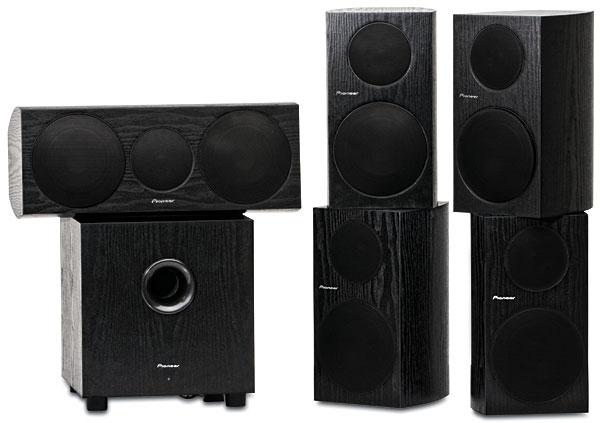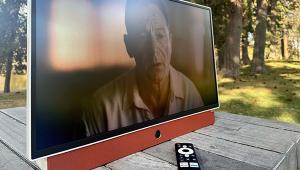Fugly
Pioneer SP-BS41-LR Speaker System

Andrew Jones for All
Isn’t it preposterous for the Pioneer Corporation to assert itself as a loudspeaker manufacturer? After all, the company is best known in the home theater sphere as a maker of audio/video receivers. Those with just slightly longer memories recall Pioneer’s world-class KURO plasmas as some of the best HDTVs ever made. There was a time when the Laserdisc format, which Pioneer championed, was the signal source of choice among videophiles. Pioneer was also one of the Japanese audio brands that established the stereo receiver as a staple of dorm rooms (including mine) during the 1970s. But who thinks of Pioneer in connection with speakers?
For starters, Pioneer does. The company’s first product back in 1937 was a loudspeaker. The following year, company founder Nozomu Matsumoto opened the Fukuin Shokai Denki Seisakusho radio and speaker repair shop in Tokyo, which eventually became the Pioneer we know today. Bullet points on the Pioneer and Wiki sites mention further speaker introductions in 1953 and 1976, including a model created by an ex-JBL engineering team. So it’s no surprise that Pioneer got acquainted with another Western speaker designer in 1997: Englishman Andrew Jones, formerly chief engineer for KEF and Infinity.
Under the aegis of TAD (Technical Audio Devices), Jones has designed studio-quality speakers that have turned heads in consumer hi-fi circles. Under the Pioneer Elite brand, he has followed up with the acclaimed EX Series, a high-end consumer line. I reviewed the S-2EX threeway monitor [Home Theater, February 2007] and still remember its enormous, golden, feelgood midrange and authoritatively solid bass. Now the Pioneer/Jones relationship has produced a new speaker line designed for those of us on a budget. Whereas the S-2EX currently commands $7,000 per pair, the SP-BS41-LR sells for a mere $149 per pair.
Is Andrew Jones willing to put his reputation on the line for a line of speakers that’s clearly meant to complement Pioneer’s lower-priced AVRs? Apparently so. The back plates literally bear his signature, A. Jones.
Zapped, Pressed, Curved
While I don’t turn up my nose at compact satellite speakers, the SP-BS41-LR is something else entirely. It’s nearly 14 inches tall, earning our monitor designation. According to the manual, it will sound best mounted on a stand 2 feet from the wall. The enclosures curve inward toward the back, eliminating parallel flat side surfaces. In turn, that reduces sound-muddying standing waves inside the speaker.

The curves come from a bonding process which my company contact was kind enough to describe: “A 12mm sheet of medium-density fiberboard is inserted between curved aluminum plates, one convex, one concave, with each plate connected to a high-power RF energy source. The RF field that is created between the aluminum plates heats the resin within the MDF and softens it. The plates are then pressed together to force the MDF to take on the curvature of the plates. The field is removed, the resin recures, and the MDF takes on a permanent curvature.” This is not how you build a cheap speaker. This is how you build a speaker with—dare I say it?—high-end aspirations.
The speaker has an unusual appearance. The front is innocent of screws and matches the black vinyl wood-patterned wrap of the sides and back. In lieu of a fabric grille covering the entire baffle, nondetachable metal grilles mask each driver, making these speakers as toddler-proof as a standmount speaker can be (although they still might get knocked off their stands). The Pioneer logo is located between the drivers, flush left, nonconformist-style.
The two-way design features a 1-inch silk-dome tweeter and a 5.25-inch plastic-cone woofer with oversized magnets (90mm in diameter by 15mm thick), and a sophisticated multi-component crossover. The baskets are made of pressed metal. This isn’t as good as the die-cast metal that more expensive speakers use, but in many ways, it’s better than the commodity-grade plastic used in the cheapest ones. Round metal-nut gold-plated binding posts grace the back, along with a port. The use of real binding posts is always a good sign. A speaker designer who uses signal-strangling wire clips on a speaker this size is one who has simply stopped trying.
- Log in or register to post comments

lines around my eyes and varied face areas that absolutely nonexistent from my face through such active methodology.
where to buy phytoceramides

These speakers are great. They work for both music and movies. The bass response is excellent.Highs are not pushed or over the top.The better the amplifier you hook these up to, the better they sound. I have these paired with the Sp-CS21.The CS21 is an excellent center channel, voices sound crisp,clear and defined. Bass response is excellent as well.
Pioneer and Mr. Jones really did a great job on this set of budget speakers. It's nice to get a quality product with a great price.

This is a very tempting system. I note that Pioneer is offering a step down system with the same Center and Sub with SP-BS21s in place of the SP-BS41s--for just $399. (The BS21s apparently bear A. Jones's signature as well.) I'd be interested to know how the BS21-based system would compare... for the budget-conscious (or simply budget-constrained!) that lower price tag is particularly compelling!

I'm new in the home theater area and ordered this system. I wanted to know what connection I needed to hook up that sub-woofer to my receiver.


I am confused about something. I have an Onkyo TX-NR509, which lists "110 watts minimum continuous power per channel, 6 ohm loads, 2 channels driven at 1 kHz, with a maximum total
harmonic distortion of 0.9% (FTC)".
And the Pioneer speakers are all (SP-BS41 and SP-BS21) listed at 6 ohms, with the BS21 listed for 80 watts, and the BS41 listed at 130 watts.
So am I correct that I need the BS-41s, since the Onkyo will push more power than the BS-21s can handle? I will mostly use them as 5.1, but may sometimes use only 2 channel mode, which means (I think) that the Onkyo will push 110 watts to 2 speakers, and the BS-21s can't handle that.
Or am I totally consfused?
Thanks for any help.

Your Onkyo at 110 watts per channel is fine for any speaker of any kind unless you get into lower Ohms, but besides that it is always better to have as much power as you can afford. The 110 watts is your receivers most likely the max output not continuous and even if it is continuous 110watts that only means it can run at 110 watts with no damage to your internal amp, the volume control is what is going increase the power output of your Onkyo so as long as you do not push any speaker to the point of distortion or past the rated power input of the speaker, so you always have to be careful when playing any speaker to high volumes. You blow out a speaker faster with an under powered amps/receivers than you will with high powered equipment, I have blown a lot of speakers over the years both ways too little power and too much power, rule of thumb never ever push a speaker to the point of distortion, If you have to little power you will not only blow your speakers out you may damage your power amp/receiver at the same time and if you have a lot of power more than your speaker can handle and you push the speakers till they distort and sound bad you will blow a tweeter first or destroy your speaker completely. So on that note your Onkyo has a nice supply and both speakers are fine to run. I have learned you can not have too much power the more in most cases the better the sound you do not have to use all you have.

That just means that your Onkyo can run at 110 watts for a long period of time without any damage to itself thus continuous, it does not mean that is the amount of power that it is sending out to you speakers as soon as you here sound, 110watts would be very very loud. I would say that you may have to turn the volume up to the half way point on your Onkyo to reach that kind of output. Most of the time you are most likely only using anywhere from 5 watts to 30-40 watts in general listening even at 40 watts I think It will be pretty loud. I hope this helps.

I think you can still buy outboard power monitors for stereo so you could see how much power your are using, I think if the are still available they will only monitor the two front main speakers on a 5.1 system but that is fine, they are fun to watch also, leds that flicker to the beat of music as to how much power the music is demanding from your equipment.

http://store.qkits.com/aboutus.cfm, this the best place I could find for power monitor kits, not easy to find already built ones these days.

Strangely, this system is discontinued on the Pioneer website. They instead have on their current list (in the same range) the cheaper "SP-PK21BS" 5.1 Speaker Package or the more expensive "SP-PK51FS" 5.1 Speaker Package including two floor standing speakers.
Would anyone be able to shed some light on the capabilities of these two systems as compared to the SP-BS41-LR.































































